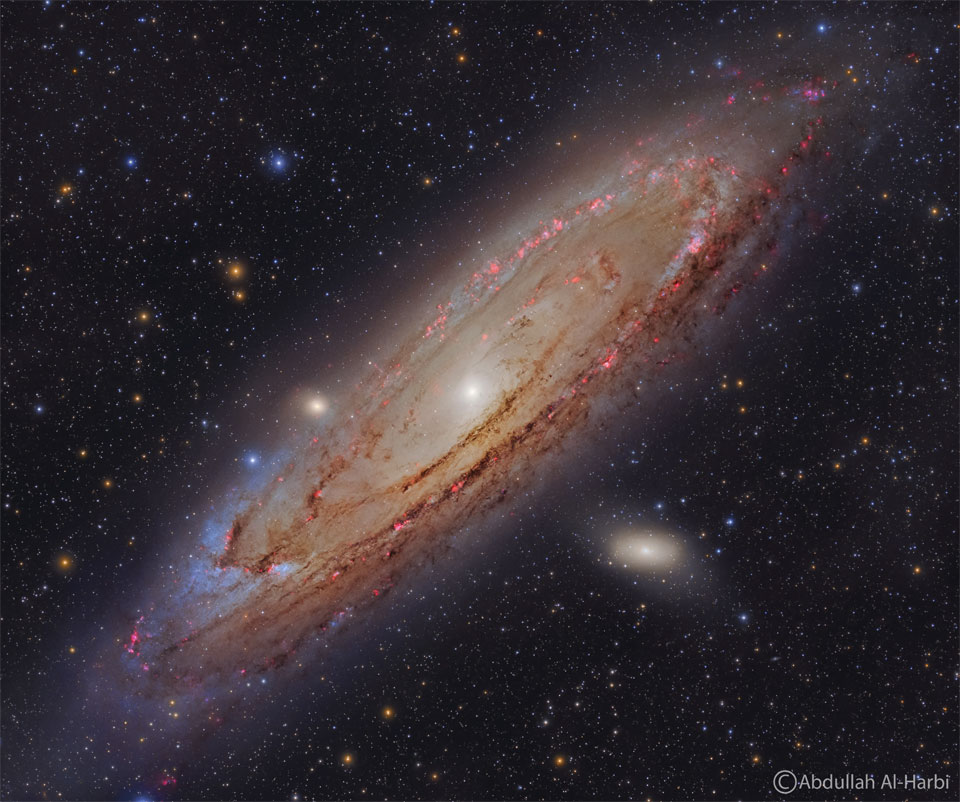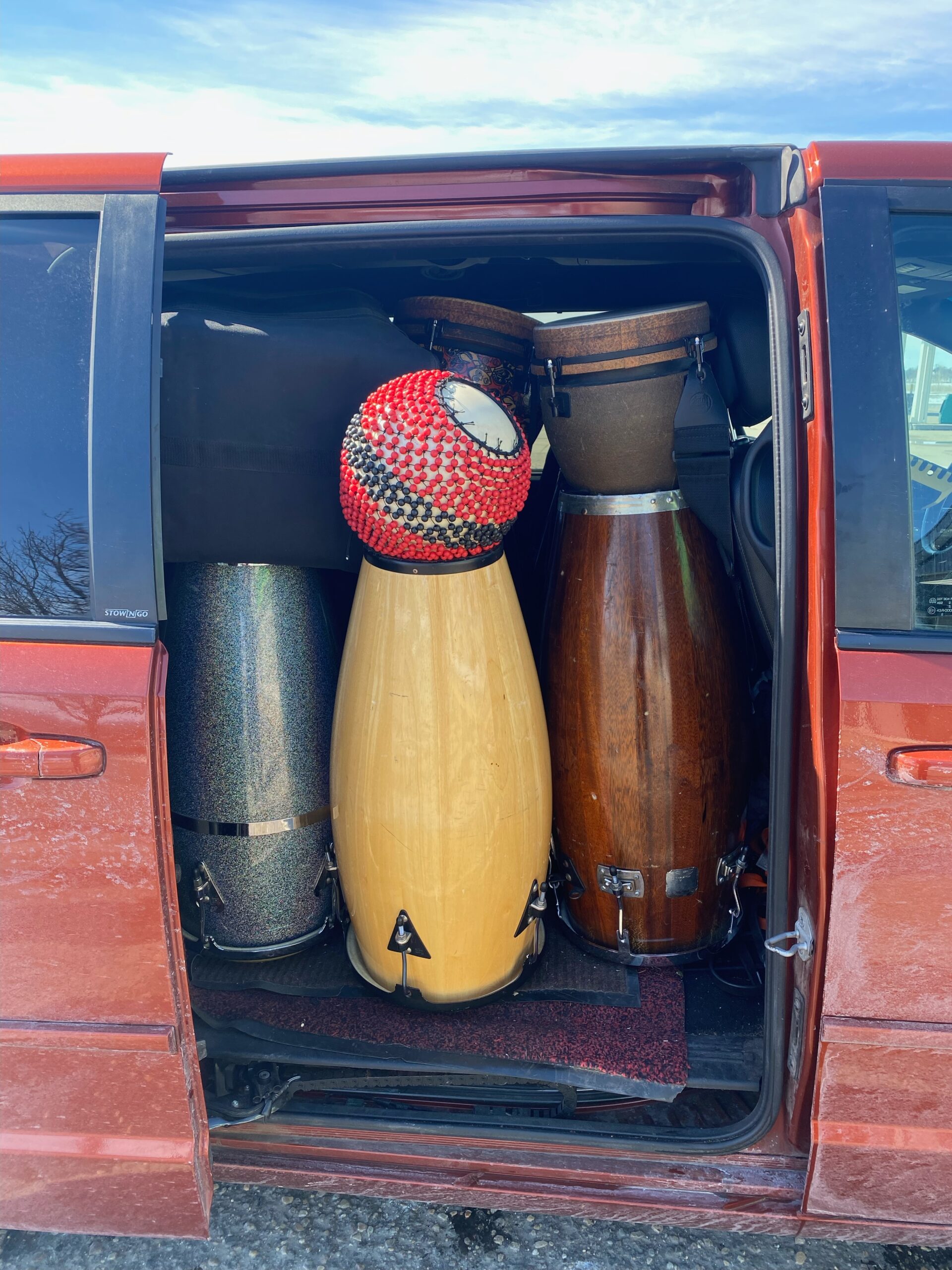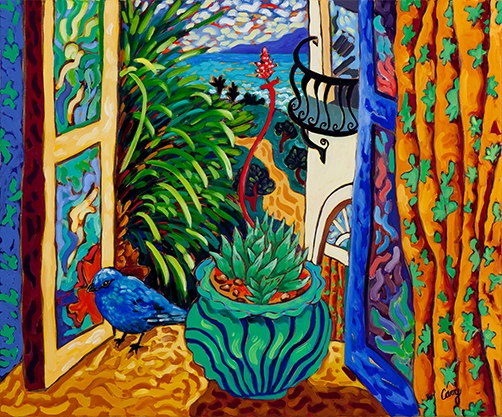Blog
“I believe that the moment is near when by a procedure of active paranoic thought, it will be possible…to systematize confusion and contribute to the total discrediting of the world of reality.”
Salvador Dali, 1930

The 3rd day of the Rhythm Roots Workshop Residency at Lincoln Elementary in Ivanhoe, MN. Exploring international rhythms and culture.

more...
The most distant object easily visible to the unaided eye is M31, the great Andromeda Galaxy, over two million light-years away. Without a telescope, even this immense spiral galaxyappears as an unremarkable, faint, nebulous cloud in the constellation Andromeda. But a bright white nucleus, dark winding dust lanes, luminous blue spiral arms, and bright red emission nebulas are recorded in this stunning fifteen-hour telescopic digital mosaic of our closest major galactic neighbor. But how do we know this spiral nebula is really so far away? This question was central to the famous Shapley-Curtis debate of 1920. M31’s great distance was determined in the 1920s by observations that resolved individual stars that changed their brightness in a way that gave up their true distance. The result proved that Andromeda is just like our Milky Way Galaxy — a conclusion making the rest of the universe much more vast than had ever been previously imagined.

Fred Anderson (March 22, 1929 – June 24, 2010) was an American jazz tenor saxophonist who was based in Chicago, Illinois. Anderson’s playing was rooted in the swing music and hard bop idioms, but he also incorporated innovations from free jazz. Anderson was also noted for having mentored numerous young musicians. Critic Ben Ratliff called him “a father figure of experimental jazz in Chicago”. Writer John Corbett referred to him as “scene caretaker, underground booster, indefatigable cultural worker, quiet force for good.” In 2001, author John Litweiler called Anderson “the finest tenor saxophonist in free jazz/underground jazz/outside jazz today.” Anderson was born in Monroe, Louisiana. When he was ten, his parents separated, and he moved to Evanston, Illinois, where he initially lived with his mother and aunt in a one-room apartment. When Anderson was a teenager, a friend introduced him to the music of Charlie Parker, and he soon decided he wanted to play saxophone, purchasing his first instrument for $45.
more...Andrew Lloyd Webber, Baron Lloyd-Webber Kt (born 22 March 1948), is an English composer and impresario of musical theatre. Several of his musicals have run for more than a decade both in the West End and on Broadway. He has composed 21 musicals, a song cycle, a set of variations, two film scores, and a Latin Requiem Mass.
Several of his songs have been widely recorded and were successful outside of their parent musicals, such as “Memory” from Cats, “The Music of the Night” and “All I Ask of You” from The Phantom of the Opera, “I Don’t Know How to Love Him” from Jesus Christ Superstar, “Don’t Cry for Me Argentina” from Evita, and “Any Dream Will Do” from Joseph and the Amazing Technicolor Dreamcoat. In 2001, The New York Timesreferred to him as “the most commercially successful composer in history”. The Daily Telegraph ranked him the “fifth most powerful person in British culture” in 2008, lyricist Don Black writing “Andrew more or less single-handedly reinvented the musical.”
He has received a number of awards, including a knighthood in 1992, followed by a peerage for services to the arts, six Tonys, three Grammys (as well as the Grammy Legend Award), an Academy Award, 14 Ivor Novello Awards, seven Olivier Awards, a Golden Globe, a Brit Award, the 2006 Kennedy Center Honors, the 2008 Classic Brit Award for Outstanding Contribution to Music, and an Emmy Award. He is one of 18 people to have won an Oscar, an Emmy, a Grammy, and a Tony. He has a star on the Hollywood Walk of Fame, is an inductee into the Songwriter’s Hall of Fame, and is a fellow of the British Academy of Songwriters, Composers, and Authors.
His company, the Really Useful Group, is one of the largest theatre operators in London. Producers in several parts of the UK have staged productions, including national tours, of the Lloyd Webber musicals under licence from the Really Useful Group. Lloyd Webber is also the president of the Arts Educational Schools, London, a performing arts school located in Chiswick, West London. He is involved in a number of charitable activities, including the Elton John AIDS Foundation, Nordoff Robbins, Prostate Cancer UK and War Child. In 1992, he started the Andrew Lloyd Webber Foundation which supports the arts, culture, and heritage of the UK. In 2014 he designed a Cats-themed Paddington Bear statue, which was auctioned to raise funds for the National Society for the Prevention of Cruelty to Children (NSPCC).
more...George Washington Benson (born March 22, 1943) is an American guitarist, singer, and songwriter. He began his professional career at the age of 19 as a jazz guitarist.
A former child prodigy, Benson first came to prominence in the 1960s, playing soul jazz with Jack McDuff and others. He then launched a successful solo career, alternating between jazz, pop, R&B singing, and scat singing. His album Breezin’ was certified triple-platinum, hitting no. 1 on the Billboard album chart in 1976.His concerts were well attended through the 1980s, and he still has a large following. Benson has won ten Grammy Awards and has been honored with a star on the Hollywood Walk of Fame.
Benson was born and raised in the Hill District of Pittsburgh, Pennsylvania. At the age of seven, he first played the ukulele in a corner drug store, for which he was paid a few dollars. At age eight, he played guitar.
more...Leo “Bud” Welch (March 22, 1932 – December 19, 2017) was an American gospel blues musician and guitarist. He started his music career in 2014, with the release of the album Sabougla Voices by Big Legal Mess Records. His subsequent studio album, I Don’t Prefer No Blues, also recorded for Big Legal Mess, was released in 2015.
Welch was born on March 22, 1932, in the town of Sabougla, Mississippi. He was a lumberjack for 30 years while he learned his musical craft in the Mississippi Delta, where he learned to play various instruments, including the fiddle, harmonica, and guitar.
more...The Taurus molecular cloud has several bright stars, but it is the dark dust that really draws attention. The pervasive dust has waves and ripples and makes picturesque dust bunnies, but perhaps more importantly, it marks regions where interstellar gas is dense enough to gravitationally contract to form stars. In the image center is a light cloud lit by neighboring stars that is home not only to a famous nebula, but to a very young and massive famous star. Both the star, T Tauri, and the nebula, Hind’s Variable Nebula, are seen to vary dramatically in brightness — but not necessarily at the same time, adding to the mystery of this intriguing region. T Tauri and similar stars are now generally recognized to be Sun-like stars that are less than a few million years old and so still in the early stages of formation. The featured image spans about four degrees not far from the Pleiades star cluster, while the featured dust field lies about 400 light-years away.

David Perry Lindley (March 21, 1944 – March 3, 2023) was an American musician who founded the rock band El Rayo-X and worked with many other performers including Jackson Browne, Linda Ronstadt, Ry Cooder, Bonnie Raitt, Warren Zevon, Curtis Mayfield and Dolly Parton. He mastered such a wide variety of instruments that Acoustic Guitar magazine referred to him not as a multi-instrumentalist but instead as a “maxi-instrumentalist.” On stage, Lindley was known for wearing garishly colored polyester shirts with clashing pants, gaining the nickname the Prince of Polyester.
The majority of the instruments that Lindley played are string instruments, including violin, acoustic and electric guitar, upright and electric bass, banjo, mandolin, dobro, hardingfele, bouzouki, cittern, bağlama, gumbus, charango, cümbüş, oud and zither. He was the unparalleled master of the lap steel guitar in the rock music sphere, and an expert in Hawaiian-style slide guitar blues. Multi-instrumentalist Ben Harperacknowledges Lindley as an important influence.
Lindley was a founding member of the 1960s psychedelic band Kaleidoscope and worked as musical director for several touring artists. He occasionally scored and composed music for film.
David Perry Lindley was born in San Marino, California, to Margaret (née Wells) and John Lindley on March 21, 1944. When Lindley was growing up in Los Angeles, his father had an extensive collection of 78 rpm records that included Korean folk and Indian sitar music, as well as Spanish classical guitarists Andrés Segovia and Carlos Montoya.
more...Otis Spann (March 21, 1924 or 1930 – April 24, 1970) was an American blues musician, whom many consider to be the leading postwar Chicago blues pianist.
Sources differ over Spann’s early years. Some state that he was born in Jackson, Mississippi, in 1930, but researchers Bob Eagle and Eric LeBlanc concluded on the basis of census records and other official information that he was born in 1924 in Belzoni, Mississippi.
Spann’s father was, according to some sources, a pianist called Friday Ford. His mother, Josephine Erby, was a guitarist who had worked with Memphis Minnie and Bessie Smith, and his stepfather, Frank Houston Spann, was a preacher and musician. One of five children, Spann began playing the piano at the age of seven, with some instruction from Friday Ford, Frank Spann, and Little Brother Montgomery.
By the age of 14, he was playing in bands in the Jackson area. He moved to Chicago in 1946, where he was mentored by Big Maceo Merriweather. Spann performed as a solo act and with the guitarist Morris Pejoe, working a regular spot at the Tic Toc Lounge. Spann was known for his distinctive piano style. He became Muddy Waters‘ piano player in late 1952 and participated in his first recording session with the band on September 24, 1953. He played on many of Waters’ most famous songs, including the blues standards“Hoochie Coochie Man“, “I’m Ready“, and “Got My Mojo Working“. He continued to record as a solo artist and session player with other musicians, including Bo Diddley and Howlin’ Wolf, during his tenure with the group. He stayed with Muddy Waters until 1968.
more...Edward James “Son” House Jr. (March 21, 1902 – October 19, 1988) was an American Delta bluessinger and guitarist, noted for his highly emotional style of singing and slide guitar playing.
After years of hostility to secular music, as a preacher and for a few years also working as a church pastor, he turned to blues performance at the age of 25. He quickly developed a unique style by applying the rhythmic drive, vocal power and emotional intensity of his preaching to the newly learned idiom. In a short career interrupted by a spell in Parchman Farm penitentiary, he developed his musicianship to the point that Charley Patton, the foremost blues artist of the Mississippi Delta region, invited him to share engagements and to accompany him to a 1930 recording session for Paramount Records.
Issued at the start of the Great Depression, the records did not sell and did not lead to national recognition. Locally, House remained popular, and in the 1930s, together with Patton’s associate Willie Brown, he was the leading musician of Coahoma County. There he was a formative influence on Robert Johnson and Muddy Waters. In 1941 and 1942, House and the members of his band were recorded by Alan Lomax and John W. Work for the Library of Congress and Fisk University. The following year, he left the Delta for Rochester, New York, and gave up music.
In 1964, a group of young record collectors discovered House, whom they knew of from his records issued by Paramount and by the Library of Congress. With their encouragement, he relearned his repertoire and established a career as an entertainer, performing for young, mostly white audiences in coffeehouses, at folk festivals and on concert tours during the American folk music revival, billed as a “folk blues” singer. He recorded several albums, and some informally taped concerts have also been issued as albums. House died in 1988. In 2017, his single “Preachin’ the Blues” was inducted in to the Blues Hall of Fame.
House was born in the hamlet of Lyon, north of Clarksdale, Mississippi, the second of three brothers, and lived in the rural Mississippi Delta until his parents separated, when he was about seven or eight years old.
more...Teaching a Rhythm Roots Workshop world drumming Residency Monday March 20th thru Friday March 24th 2023 at Lincoln Elementary in Ivanhoe, MN And lots of snow and ice still on the country roads.



The galaxy JW100 features prominently in this image from the NASA/ESA Hubble Space Telescope, with streams of star-forming gas dripping from the disc of the galaxy like streaks of fresh paint. These tendrils of bright gas are formed by a process called ram pressure stripping, and their resemblance to dangling tentacles has led astronomers to refer to JW100 as a ‘jellyfish’ galaxy. It is located in the constellation Pegasus, over 800 million light-years away. Ram pressure stripping occurs when galaxies encounter the diffuse gas that pervades galaxy clusters. As galaxies plough through this tenuous gas it acts like a headwind, stripping gas and dust from the galaxy and creating the trailing streamers that prominently adorn JW100. The bright elliptical patches in the image are other galaxies in the cluster that hosts JW100. As well as JW100’s bright tendrils, this image also contains a remarkably bright area of diffuse light towards the top of this image which contains two bright blotches at its core. This is the core of IC 5338, the brightest galaxy in the galaxy cluster, known as a cD galaxy. It’s not unusual for cD galaxies to exhibit multiple nuclei, as they are thought to grow by consuming smaller galaxies, the nuclei of which can take a long time to be absorbed. The bright points of light studding its outer fringes are a rich population of globular clusters. This observation took advantage of the capabilities of Hubble’s Wide Field Camera 3, and is part of a sequence of observations designed to explore star formation in the tendrils of jellyfish galaxies. These tendrils represent star formation under extreme conditions, and could help astronomers understand the process of star formation elsewhere in the universe. [Image description: A thin spiral galaxy is seen edge-on in the lower right. Its bulge and arms are very bright, mixing reddish and bluish light. Patchy blue trails extend below it, resembling tentacles, made from star-forming regions.

More Posts
- Oumou Sangaré
- George Harrison
- Ida Cox
- World Music La Yegros
- Daily Roots Message
- Revolution & Dancing
- Cosmos RCW 16
- Nicky Hopkins
- David “Fathead” Newman
- World Music CHAKANA
- Daily Roots U Roy
- CELESTIAL ANTIQUITY Event 3-28-24
- Mt Zion Shabbat for the Soul
- Cosmos NGC 2736
- Wayne Escoffery
- Rusty Young
- Johnny Winter
- Flamenco Fridays Fandangos Camerón
- Daily Roots The Mellowtones
- Cosmos M106 NGC 4217


